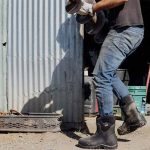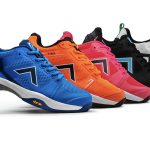Gildan Activewear Inc. blew through its $50 million goal for new programs at its Branded Apparel division in fiscal 2013 and expects to place $100 million in additional programs in fiscal 2014, President and CEO Glenn Chamandy told analysts during the company’s fourth quarter earnings call.
Chamandy said the division added about $70 million in new programs in the fiscal year ended Sept. 29, while dropping about $30 million in private label work, including a Starter underwear program at Walmart. The new business is coming from the sale of in-house sock brands Gold Toe and Gildan Premium and in-house underwear brand G.
GIL reported last week that net sales grew 11.5 percent to $626.2 million in the fourth quarter ended Sept. 29. Sales could have grown even more if not for capacity constraints at its Printwear business, where sales rose 12.5 percent to $423.9 million on an 18.7 percent increase in units. The growth was driven by a 37 percent. increase in unit shipments to international markets driven by Europe and Asia. Growth also improved in the United States, where wholesalers who had whittled down inventories in the fiscal fourth quarter of 2012, shifted to replenishing them in 2013. Higher volume in the recent quarter was partially offset by lower net selling prices, which declined throughout the quarter in tandem with cotton prices.
In the Branded Apparel segment, sales reached $202.2 million, up 9.4 percent. Strong sell through of the in-house sock brands was partially offset by the company’s decision to exit certain retailer private label programs.
In the Branded Apparel segment, sales reached $202.2 million, up 9.4 percent. Strong sell through of the in-house sock brands was partially offset by the company’s decision to exit certain retailer private label programs.
Consolidated gross margins slipped 20 basis points to 28.3 percent as the positive impact of lower-cost cotton and increased supply chain and manufacturing efficiencies was offset by the impact of lower net selling prices for Printwear.
Higher market, advertising and compensation costs drove SG&A expenses up 8.7 percent to $69.7 million. SG&A as a percentage of sales, however, dropped to 11.1 percent, down 30 basis points from the fourth quarter of 2012. Operating income surged 19.7 percent at Branded Apparel, greatly exceeding expectations.
Higher market, advertising and compensation costs drove SG&A expenses up 8.7 percent to $69.7 million. SG&A as a percentage of sales, however, dropped to 11.1 percent, down 30 basis points from the fourth quarter of 2012. Operating income surged 19.7 percent at Branded Apparel, greatly exceeding expectations.
Net earnings reached $96.8 million, up 8.8 percent. Adjusted net earnings, which exclude after tax restructuring and acquisition charges, increased 7.5 percent to a fourth quarter record of $102.0 million.
While GIL expects retail markets to remain soft in fiscal 2014, it forecast fiscal 2014 revenue and earnings will grow in the 7.5 percent and 11.5-to-15.2-percent range respectively. This translates to revenue growth of 15 percent at Branded Apparel, where sales are expected to reach $825 million and 2 percent at Printwear, where declining ASPs are expected to continue offsetting international growth and bring in $1.5 billion.
The Printwear forecast anticipates U.S. revenues will grow 3 percent on a 5 percent increase in unit sales as declining cotton prices force the company to offer promotional discounts in the 2 percent range through March, 2014.
“We are continuing to obtain new retail programs and are expanding our brand presence across all channels of distribution through our brand extensions such as Gildan Platinum and G by Gold Toe, which have both been placed in department stores and national chains,” said Chamandy. “In addition, we announced that we have obtained the licenses for Mossy Oak for activewear, underwear and socks. All of our retail customers are very excited about the brand and it's going to allow us to sell a premium product and it demands a premium. It’s going to be big.”
With its Gold Toe and Anvil Knitwear acquisitions now integrated into its operations, Gildan will resume targeting acquisitions and expanding its production capacity in Central America for both the U.S. and European markets and in anticipation that more apparel companies will shift production from Bangladesh and other offshore locations to limit reputation risk.
“We're expanding rapidly our fleece production as we speak,” Chamandy said. “We're actually building a new sewing facility to keep up because it's not necessarily a textile capacity restraint because our plants are really versatile. It's more the ability to get all the operators in place to sew the product.”
The company plans to invest up to $350 million in fiscal 2014 expanding yarn production in North Carolina, modernizing and expanding Anvil’s factories in Honduras and selecting, designing and breaking ground on a new textile and garment manufacturing hub in a yet-to-be-named Central American country.
“We're not just building a site to put one textile factory, we're putting a site up to build a multitude of textile factories so that we can support not just the growth for 2016 and 2015 beyond that,” Chamandy said. “We think that this hemisphere is the place to produce for our customer needs and this will allow us to have a good diversified portfolio of manufacturing, continue to lower our cost structure and be able to bring speed to market as this capacity comes on.”















